-
 Bitcoin
Bitcoin $106,754.6083
1.33% -
 Ethereum
Ethereum $2,625.8249
3.80% -
 Tether USDt
Tether USDt $1.0001
-0.03% -
 XRP
XRP $2.1891
1.67% -
 BNB
BNB $654.5220
0.66% -
 Solana
Solana $156.9428
7.28% -
 USDC
USDC $0.9998
0.00% -
 Dogecoin
Dogecoin $0.1780
1.14% -
 TRON
TRON $0.2706
-0.16% -
 Cardano
Cardano $0.6470
2.77% -
 Hyperliquid
Hyperliquid $44.6467
10.24% -
 Sui
Sui $3.1128
3.86% -
 Bitcoin Cash
Bitcoin Cash $455.7646
3.00% -
 Chainlink
Chainlink $13.6858
4.08% -
 UNUS SED LEO
UNUS SED LEO $9.2682
0.21% -
 Avalanche
Avalanche $19.7433
3.79% -
 Stellar
Stellar $0.2616
1.64% -
 Toncoin
Toncoin $3.0222
2.19% -
 Shiba Inu
Shiba Inu $0.0...01220
1.49% -
 Hedera
Hedera $0.1580
2.75% -
 Litecoin
Litecoin $87.4964
2.29% -
 Polkadot
Polkadot $3.8958
3.05% -
 Ethena USDe
Ethena USDe $1.0000
-0.04% -
 Monero
Monero $317.2263
0.26% -
 Bitget Token
Bitget Token $4.5985
1.68% -
 Dai
Dai $0.9999
0.00% -
 Pepe
Pepe $0.0...01140
2.44% -
 Uniswap
Uniswap $7.6065
5.29% -
 Pi
Pi $0.6042
-2.00% -
 Aave
Aave $289.6343
6.02%
Why did the stock plummet after the large-volume breakthrough? The three characteristics of the main force's shipment are revealed!
A high-volume breakout often signals strength, but prices may drop as institutional players manipulate volume and sentiment to offload holdings.
Jun 12, 2025 at 05:56 pm
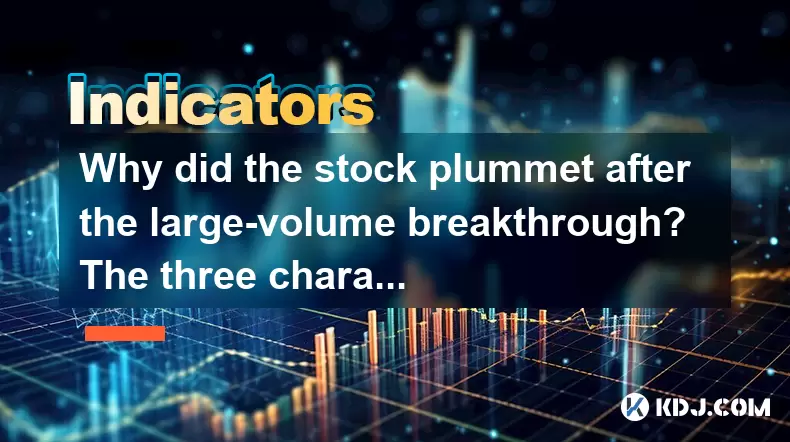
Understanding the Market Reaction to High-Volume Breakouts
When a cryptocurrency or stock experiences a high-volume breakout, many investors expect a continued upward trend. However, in some cases, prices plummet shortly after such an event. This phenomenon is not random but often tied to specific behaviors by large institutional players—commonly referred to as the "main force." Understanding these dynamics can help traders avoid losses and make more informed decisions.
One of the primary reasons for a price drop after a high-volume breakout lies in how market sentiment shifts post-breakout. Often, retail traders rush in when they see a surge in volume and price, interpreting it as a strong bullish signal. Unfortunately, this enthusiasm is sometimes exploited by larger players who use the momentum to offload their holdings.
Characteristic One: Pumping Volume to Trigger Retail Buying Frenzy
A key tactic employed by the main force involves artificially inflating trading volume to create the illusion of strong demand. This can be done through wash trading or coordinated buying that pushes the price past critical resistance levels. The result is a spike in volume that excites retail traders, prompting them to enter the market at elevated prices.
- High volume appears suddenly, often without a corresponding news catalyst.
- The price surges rapidly but lacks fundamental support.
- Market depth shows thin order books despite heavy volume, indicating fake liquidity.
This manipulation strategy allows big players to exit their positions at favorable prices while leaving retail traders holding the bag when the price collapses.
Characteristic Two: Fake Breakouts to Lure Traders Into Long Positions
Another common technique used by the main force is the creation of false breakouts. These occur when the price moves above a key technical level—such as a resistance zone or moving average—only to reverse sharply afterward. The goal is to trigger automated trading systems and entice retail buyers who believe the asset has entered a new bullish phase.
- Price breaks key levels temporarily, often with exaggerated candlestick patterns.
- Breakouts fail quickly, with the price returning below the broken level within hours.
- Volume during the breakout may appear suspiciously one-sided or manipulated.
Traders relying on technical signals without deeper analysis often fall into this trap, entering long positions just before the reversal begins.
Characteristic Three: Distribution During Euphoria Phase
Once the hype reaches its peak, the main force begins to distribute their holdings to the market. This distribution occurs subtly over time, often masked by continued positive sentiment or social media buzz. As the large players sell, the lack of real demand becomes evident, leading to a rapid decline in price.
- Sustained selling pressure emerges even though public sentiment remains bullish.
- On-chain data shows increased movement from whale wallets to exchanges.
- Order book imbalances begin to appear, especially on major exchanges.
Retail traders, unaware of this behind-the-scenes activity, continue buying until the market runs out of steam and collapses under its own weight.
How to Identify and Avoid Main Force Shipments
Avoiding the pitfalls of main force shipments requires a combination of technical analysis, on-chain monitoring, and behavioral awareness. Here are actionable steps traders can take:
- Analyze volume profiles across multiple exchanges to detect anomalies.
- Use tools like Glassnode or Santiment to track large wallet movements and exchange inflows.
- Monitor for divergences between price action and volume indicators.
- Avoid chasing breakouts unless supported by strong fundamentals or macro developments.
- Set stop-loss orders to protect against sudden reversals following high-volume events.
By staying vigilant and using available data, traders can reduce their exposure to manipulative tactics and improve their chances of navigating volatile markets successfully.
Frequently Asked Questions (FAQs)
What is a "main force" in cryptocurrency trading?
The term "main force" refers to large institutional players or whales who have significant capital and influence over market movements. They often manipulate price and volume to gain advantages over smaller traders.
How can I differentiate between a real breakout and a fake one?
Real breakouts typically feature sustained volume, strong fundamentals, and broad market participation. Fake breakouts show weak follow-through, inconsistent volume, and often coincide with suspicious on-chain activity.
Does this phenomenon only apply to cryptocurrencies?
No, similar tactics are observed in traditional stock markets as well. However, due to lower liquidity and less regulation, crypto markets are more susceptible to such manipulations.
Can technical indicators alone prevent me from falling into this trap?
While technical indicators provide valuable insights, they should be combined with on-chain analytics and market sentiment analysis to form a comprehensive trading strategy.
Disclaimer:info@kdj.com
The information provided is not trading advice. kdj.com does not assume any responsibility for any investments made based on the information provided in this article. Cryptocurrencies are highly volatile and it is highly recommended that you invest with caution after thorough research!
If you believe that the content used on this website infringes your copyright, please contact us immediately (info@kdj.com) and we will delete it promptly.
- 2025-W Uncirculated American Gold Eagle and Dr. Vera Rubin Quarter Mark New Products
- 2025-06-13 06:25:13
- Ruvi AI (RVU) Leverages Blockchain and Artificial Intelligence to Disrupt Marketing, Entertainment, and Finance
- 2025-06-13 07:05:12
- H100 Group AB Raises 101 Million SEK (Approximately $10.6 Million) to Bolster Bitcoin Reserves
- 2025-06-13 06:25:13
- Galaxy Digital CEO Mike Novogratz Says Bitcoin Will Replace Gold and Go to $1,000,000
- 2025-06-13 06:45:13
- Trust Wallet Token (TWT) Price Drops 5.7% as RWA Integration Plans Ignite Excitement
- 2025-06-13 06:45:13
- Ethereum (ETH) Is in the Second Phase of a Three-Stage Market Cycle
- 2025-06-13 07:25:13
Related knowledge

How to confirm the effectiveness of the average price line support in the time-sharing chart?
Jun 17,2025 at 12:56am
Understanding the Time-Sharing Chart and Its RelevanceIn cryptocurrency trading, time-sharing charts play a crucial role in analyzing short-term price movements. These charts typically display price fluctuations over a specific period, often ranging from minutes to hours. Traders rely on them to make quick decisions based on real-time data. The average ...

What does it mean when the momentum indicator breaks above the zero axis?
Jun 17,2025 at 12:43am
Understanding the Momentum IndicatorThe momentum indicator is a technical analysis tool used to measure the speed or velocity of price movements in cryptocurrency markets. It helps traders identify potential trend reversals, overbought or oversold conditions, and confirms existing trends. The indicator typically oscillates around a zero line, with value...
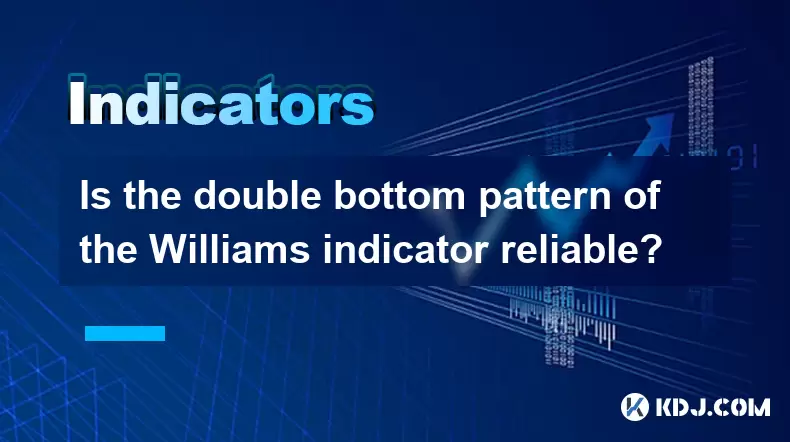
Is the double bottom pattern of the Williams indicator reliable?
Jun 17,2025 at 03:56am
Understanding the Williams Indicator and Its SignificanceThe Williams %R indicator, often referred to as Williams Percent Range, is a momentum oscillator used in technical analysis to identify overbought or oversold conditions in the market. Developed by Larry Williams, this indicator fluctuates between 0 and -100, with readings above -20 indicating ove...
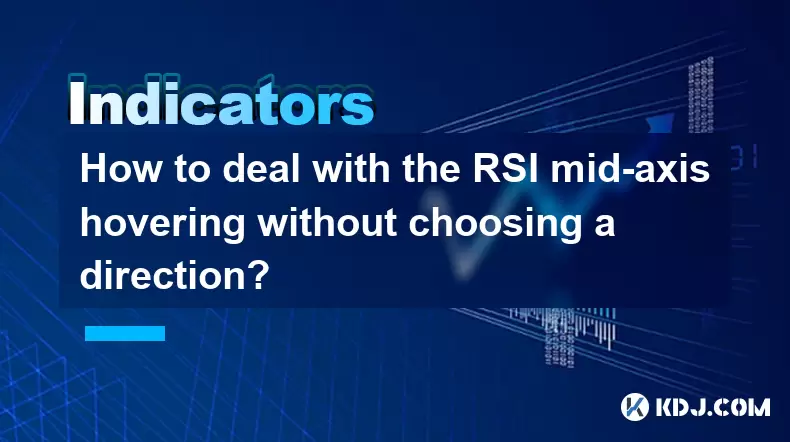
How to deal with the RSI mid-axis hovering without choosing a direction?
Jun 17,2025 at 02:02am
Understanding RSI Mid-Axis Hovering in Cryptocurrency TradingThe Relative Strength Index (RSI) is a popular momentum oscillator used by traders to assess whether an asset is overbought or oversold. In cryptocurrency markets, it's common for the RSI to hover around its mid-axis, typically at the 50 level, without showing a clear upward or downward trend....
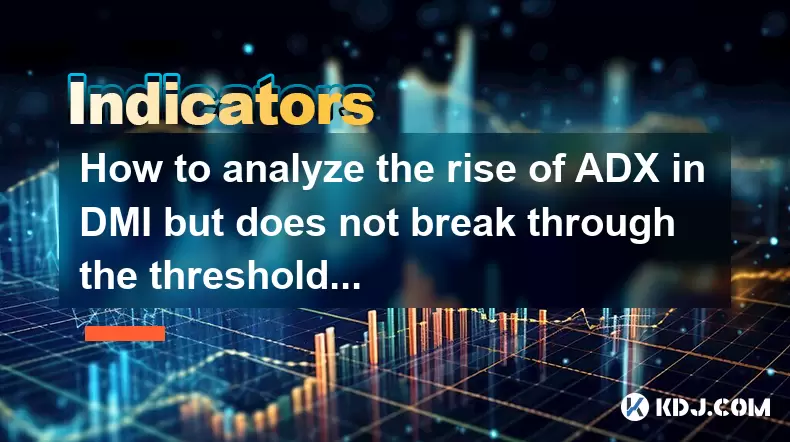
How to analyze the rise of ADX in DMI but does not break through the threshold?
Jun 16,2025 at 11:49pm
Understanding ADX and DMI in Cryptocurrency TradingIn cryptocurrency trading, ADX (Average Directional Index) is a technical indicator used to measure the strength of a trend. It works in conjunction with the DMI (Directional Movement Indicator), which includes two components: +DI (Positive Directional Indicator) and -DI (Negative Directional Indicator)...
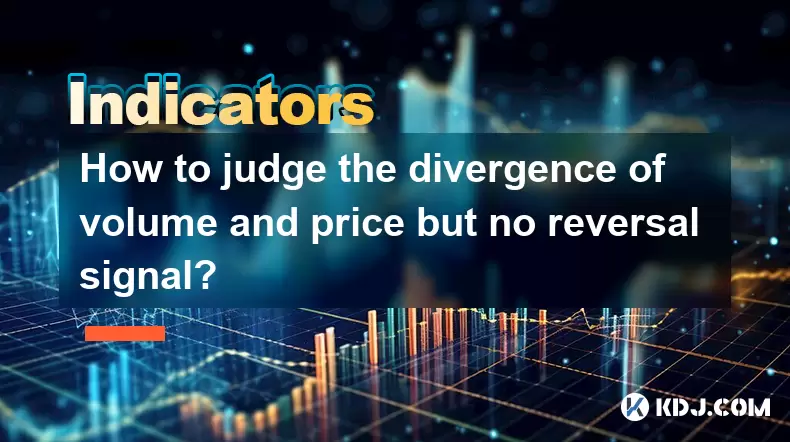
How to judge the divergence of volume and price but no reversal signal?
Jun 17,2025 at 12:28am
Understanding Volume and Price DivergenceIn the world of cryptocurrency trading, volume and price are two key indicators that traders monitor closely. Divergence occurs when these two metrics move in opposite directions. For example, if the price of a cryptocurrency is rising but its volume is declining, this could signal weakening momentum. However, it...

How to confirm the effectiveness of the average price line support in the time-sharing chart?
Jun 17,2025 at 12:56am
Understanding the Time-Sharing Chart and Its RelevanceIn cryptocurrency trading, time-sharing charts play a crucial role in analyzing short-term price movements. These charts typically display price fluctuations over a specific period, often ranging from minutes to hours. Traders rely on them to make quick decisions based on real-time data. The average ...

What does it mean when the momentum indicator breaks above the zero axis?
Jun 17,2025 at 12:43am
Understanding the Momentum IndicatorThe momentum indicator is a technical analysis tool used to measure the speed or velocity of price movements in cryptocurrency markets. It helps traders identify potential trend reversals, overbought or oversold conditions, and confirms existing trends. The indicator typically oscillates around a zero line, with value...

Is the double bottom pattern of the Williams indicator reliable?
Jun 17,2025 at 03:56am
Understanding the Williams Indicator and Its SignificanceThe Williams %R indicator, often referred to as Williams Percent Range, is a momentum oscillator used in technical analysis to identify overbought or oversold conditions in the market. Developed by Larry Williams, this indicator fluctuates between 0 and -100, with readings above -20 indicating ove...

How to deal with the RSI mid-axis hovering without choosing a direction?
Jun 17,2025 at 02:02am
Understanding RSI Mid-Axis Hovering in Cryptocurrency TradingThe Relative Strength Index (RSI) is a popular momentum oscillator used by traders to assess whether an asset is overbought or oversold. In cryptocurrency markets, it's common for the RSI to hover around its mid-axis, typically at the 50 level, without showing a clear upward or downward trend....

How to analyze the rise of ADX in DMI but does not break through the threshold?
Jun 16,2025 at 11:49pm
Understanding ADX and DMI in Cryptocurrency TradingIn cryptocurrency trading, ADX (Average Directional Index) is a technical indicator used to measure the strength of a trend. It works in conjunction with the DMI (Directional Movement Indicator), which includes two components: +DI (Positive Directional Indicator) and -DI (Negative Directional Indicator)...

How to judge the divergence of volume and price but no reversal signal?
Jun 17,2025 at 12:28am
Understanding Volume and Price DivergenceIn the world of cryptocurrency trading, volume and price are two key indicators that traders monitor closely. Divergence occurs when these two metrics move in opposite directions. For example, if the price of a cryptocurrency is rising but its volume is declining, this could signal weakening momentum. However, it...
See all articles

























































































